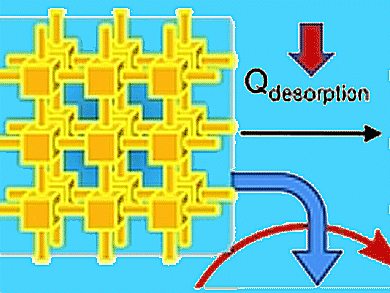The search for sustainable ways of producing energy is currently a very popular and important topic of investigation. Water adsorption/desorption is a process that can be used for the transformation of energy. Porous solids enable larger amounts of adsorption/desorption, as they provide a greater surface area. MIL-101 is such a highly porous material, a metal-organic framework that was synthesized previously and demonstrated to have very large pores. A team of researchers led by Christoph Janiak, who just moved from the University of Freiburg to the University of Düsseldorf, and Stefan Henninger at the Fraunhofer Institute for Solar Energy Systems in Freiburg investigated the water adsorption behavior and water stability of this material.
The porous material, a crystalline mesoporous chromium terephthalate metal-organic framework with inner free-cage diameters of up to 34 Å, was used in a heat pump or adsorption chiller as illustrated in the figure. Heat must be supplied for water desorption from the pores. The desorbed water is evaporated to produce useful cooling. When the water is condensed and adsorbed in the pores, the heat of adsorption is released as useful heat. The ease of adsorption and desorption as well as the stability of the material in the presence of water are important factors determining the efficiency of the setup. The material adsorbs more water than the equivalent of its own weight, and its channels and cavities allow rather fast water diffusion and rather unimpeded adsorption and desorption. Moreover, there is only slight degradation of the water uptake capacity and almost no degradation of nitrogen adsorption capacity after 40 test cycles.
The study demonstrates that MIL-101 is one of the most promising sorbent metal–organic frameworks known so far for refrigeration, heat pumping, and heat storage applications. It adsorbs one gram of water per gram and is stable even over several cycles in the presence of water.
- High Water Uptake Capacity of Mesoporous Material Ideal for Use in Heat Transformation Applications,
Johannes Ehrenmann, Stefan K. Henninger, Christoph Janiak,
Europ. J. Inorg. Chem. 2010.
DOI: 10.1002/ejic.201001156


